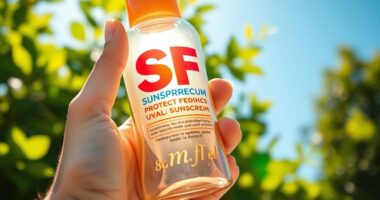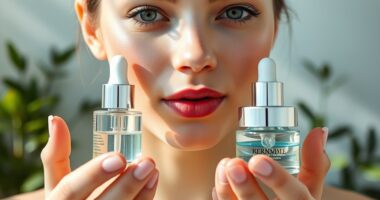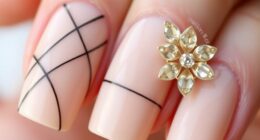Skin cycling helps you prevent over-exfoliation by balancing exfoliating days with rest and hydration days. This structured approach ensures you remove dead skin cells without stripping your skin’s natural barrier or causing irritation. By alternating between chemical exfoliants and nourishing treatments, you give your skin time to recover. This method promotes healthier, more resilient skin while reducing redness, dryness, and sensitivity. If you keep exploring, you’ll discover how to customize your schedule for maximum results.
Key Takeaways
- Skin cycling alternates exfoliation and recovery days to prevent excessive stripping of the skin’s barrier.
- Rest days allow the skin to repair, reducing irritation and redness caused by over-exfoliation.
- Scheduled exfoliation prevents daily overuse of acids or scrubs, maintaining skin health.
- Monitoring skin response helps adjust the routine, avoiding damage from overdoing chemical exfoliants.
- Balancing exfoliation with nourishing steps promotes resilience and prevents long-term skin damage.

Exfoliating your skin is essential for a radiant, smooth complexion, but overdoing it can lead to irritation and damage. That’s where skin cycling comes in—a smart approach that helps you maintain healthy skin without the risk of over-exfoliation. Instead of daily scrubbing or harsh chemical exfoliation, skin cycling involves alternating between different skincare steps on a set schedule. This method allows your skin to recover, reduces inflammation, and maintains a healthy balance of skin hydration.
Skin cycling helps prevent irritation by alternating exfoliation and nourishing steps on a set schedule.
Chemical exfoliation, when used wisely, can be incredibly effective at removing dead skin cells and promoting cell turnover. However, overusing products like acids or scrubs can strip your skin’s natural barrier, leaving it vulnerable and dry. Skin cycling minimizes this risk by scheduling exfoliation less frequently—say, a few times a week—so your skin doesn’t get overwhelmed. On the days you skip exfoliation, you focus on nourishing your skin, replenishing hydration, and strengthening the barrier. This balance prevents the dryness, redness, and irritation that often come with excessive chemical exfoliation.
A key aspect of skin cycling is understanding your skin’s needs. During exfoliation days, you might use chemical exfoliants like AHAs or BHAs, which dissolve dead cells and improve skin texture. But on rest days, you shift to hydrating and soothing products—think hyaluronic acid, ceramides, or gentle moisturizers—to boost skin hydration. This not only restores moisture but also helps repair any minor irritation caused by exfoliation. By alternating these steps, you give your skin a chance to recover and stay resilient, preventing the cycle of damage that often leads to dullness and sensitivity.
Another benefit of skin cycling is that it encourages consistency without overloading your skin. Instead of daily exfoliation, which can quickly become excessive, you create a sustainable routine that your skin can adapt to. Over time, you’ll notice improved texture, a more even tone, and healthier-looking skin. Plus, you’ll be less likely to experience setbacks like breakouts or redness caused by overly aggressive exfoliation.
Following a scheduled routine also helps you stay mindful of your skin’s response. If you notice irritation, you can adjust your schedule or switch to gentler products. This proactive approach ensures that your skin remains hydrated, calm, and protected from damage. Ultimately, skin cycling isn’t just about exfoliating less—it’s about exfoliating smarter, protecting your skin’s barrier, and maintaining ideal hydration. That way, you get a radiant glow without the setbacks or irritation that often come with overdoing chemical exfoliation.
Frequently Asked Questions
Can Skin Cycling Improve Skin Texture Faster Than Daily Exfoliation?
You might find skin cycling helps improve your skin texture faster than daily exfoliation. By alternating chemical exfoliation with recovery days, you give your skin time to repair its barrier and prevent over-exfoliation. This approach promotes smoother, healthier skin by avoiding damage caused by constant chemical exfoliation. So, your skin benefits from targeted exfoliation while still allowing essential barrier repair, making it a smarter, more effective method for faster results.
Is Skin Cycling Suitable for Sensitive or Acne-Prone Skin Types?
If you have sensitive or acne-prone skin, skin cycling can be suitable when you use gentle formulations that focus on barrier repair. This approach helps prevent irritation and over-exfoliation, allowing your skin to recover between exfoliation days. By incorporating calming products and giving your skin time to heal, you can minimize flare-ups and maintain healthier skin while still benefiting from exfoliation.
How Long Does It Typically Take to See Results From Skin Cycling?
Did you know that around 70% of people see visible improvements in their skin within just four weeks of consistent skincare? With skin cycling, you can expect to see results in about that timeframe, but timing expectations vary based on your skin type and concerns. Stay committed, and you’ll likely notice smoother, healthier skin as your routine balances exfoliation and recovery. Patience is key to achieving the best results.
Can Skin Cycling Be Combined With Other Skincare Treatments or Products?
You can absolutely combine skin cycling with other treatments or product layering, but it’s important to make sure to do so carefully. Stick to gentle ingredients and avoid overloading your skin, especially with active products like acids or retinoids. Introduce new treatments gradually, and always listen to how your skin responds. Consulting a dermatologist helps ensure your skin cycling routine complements other skincare, preventing over-exfoliation and irritation.
Are There Any Specific Ingredients to Avoid During Certain Phases?
Think of your skin as a garden, where each ingredient is a plant needing proper care. During different phases, you should avoid certain ingredients—like retinoids or acids—that could clash or cause irritation. Ingredient restrictions and compatibility are key to a healthy cycle. By steering clear of harsh or conflicting products during sensitive phases, you protect your skin’s balance, ensuring a lush, thriving glow without over-exfoliation.
Conclusion
Think of skin cycling as a gentle dance you do with your skin, giving it time to rest and recover between exfoliation steps. Just like a well-choreographed routine, it keeps your skin balanced and healthy, preventing over-exfoliation. Stick to the schedule, listen to your skin’s cues, and you’ll enjoy a glow that’s as fresh as a spring morning. Remember, patience and consistency are your best allies in achieving radiant, resilient skin.










